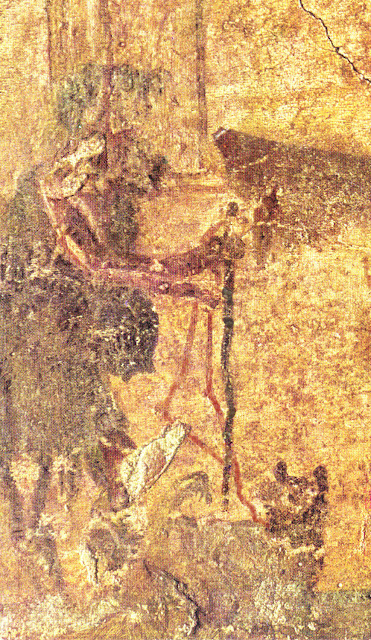Guide Dogs in the Ancient and Medieval World

Image reference: Medieval guide dog: Maastricht Hours, British Library, Stowe MS 17, fol. 135r, early 14th century - https://www.bl.uk/manuscripts/FullDisplay.aspx?ref=Stowe_MS_17
Image description: an illustrated manuscript shows a figure draped in an orange gown and white coif head covering holds a sword between their arms and raises their hand in prayer. To their right, a Saint is depicted with a golden halo around his head. The Saint is wearing a robe of orange and red with a green shawl, and is bare foot. His left hand is covering the blind man’s eyes, which are closed, whilst his right hand is pointed towards the sky and his index and middle fingers are raised. To the left of the blind man, attached by a orange chain, is a dog, staring up at the scene. The dog is not especially anatomically correct, and appears to be crouching. The dog has a collar on and is white, with a grey tail. The scene also includes some thick black Medieval Latin text.
Dogs are a key part of our lives, both today and throughout history. Guide dogs are known to have existed during the Medieval period and are illustrated in various texts throughout history across a wide and diverse range of societies and cultures. Recently, a discovery of a fresco in Pompeii has proved significant in that it is possibly one of the earliest primary sources that suggest that guide dogs existed in ancient times.
The fresco, which has unfortunately sustained quite a lot of damage over the years, depicts a man, thought to be a beggar, with a cane and a dog on a lead standing next to two women, as if he is being led to them by the dog. Historian Dr. Jane Dreycott points to the fresco and the contextual knowledge of Pompeii that many beggars were blind or visually impaired and often ‘had dogs as companions’, possibly acting as guide dogs.
As mentioned before, more concrete sources showing guide dogs can be found in the Medieval period, specifically in Europe. Many of these sources are from prayer books, meant to highlight the healing powers of Christ. Several illustrations show blind individuals and their dogs, often with their snouts in beggar bowls, or standing by proudly. As early as 1260 there are sources that show blind people using dogs, as well as servants or children, to assist them. There are also sources from Asia; a scroll from 13th century China depicts a blind man with a cane being guided by a dog, and is now on display to the public at the Metropolitan Museum.
The first recognised organised mass training of guide dogs occurred in the late 18th century. Prior to this, these pieces of evidence illustrated in frescos, manuscripts, and scrolls, show that guide dogs, and all assistance animals, have a long and rich history that possibly extends far beyond the modern period.

Image reference: ‘Seeing Eye Dog’ Chinese Scroll - Samuel P. Hayes Research Library, Perkins School for the Blind, Watertown, MA, Metropolitan Museum of Art, circa 1250
Image description: A black and white illustration depicts a man walking. He is wearing a robe and white trousers. In his right hand he is holding a cane, and his left hand is holding a dog lead. The dog is walking in front of the man, leading him, and had a curled tail and thin head. There are other figures in the scene, mostly in pairs or groups of three, talking or carrying baskets.
Sources
Disability in the Ancient World: You’re Dead to Me, BBC Sounds, Greg Jenner, Jane Dreycott, Rosie Jones - https://www.bbc.co.uk/programmes/p0b0wd4p
Transcript: https://docs.google.com/file/d/16Bjaz4kH_2UiDuL56NYnTrK8AOpDedO5/edit?usp=docslist_api&filetype=msword
Guide Dogs in Medieval Art and Writing by Dr. Krista A. Murchison - https://kristamurchison.com/medieval-guide-dogs/
‘When your eyes have a wet nose: the evolution of the use of guide dogs and establishing the seeing eye’ by Gerald A. Fishman, MD in Survey of ophthalmology, 48 (4), p. 452 - https://doi.org/10.1016/S0039-6257(03)00052-3
A History of Guide Dogs - https://www.igdf.org.uk/guide-dogs/history-of-guide-dogs/
The Cuddly Tail of Guide Dogs - https://www.smithsonianmag.com/smart-news/guide-dog-tail-180964302/
(Ella Buckingham)

Image description: Pompeii fresco: a very faded and worn illustration of a man standing facing the right. His face has almost entirely been eroded. He is wearing a dark shawl and extending both his hands. In his left hand he holds a black cane, and in his right hand a red lead tied to a dog. The dog is quite small, dark, and appears to be looking up at its owner.

Image description: Reconstruction: the same image as the fresco is presented, but far more refined and in black and white pencil. The man is more defined, and has a beard. The man is standing in front of two statues, and appears to be approaching two women, as if led by the dog. The dog is standing a little further in front of the man, and their tail curls back towards their body. The dog’s head is tilted towards their owner.
Image references: Pompeii fresco: Plate 78. p. 140, Maiuri, A., Roman Painting, Milan, Skira Publishing, 1953. Original circa 60sCE. Reconstruction by Dr. Richard Marshall.
